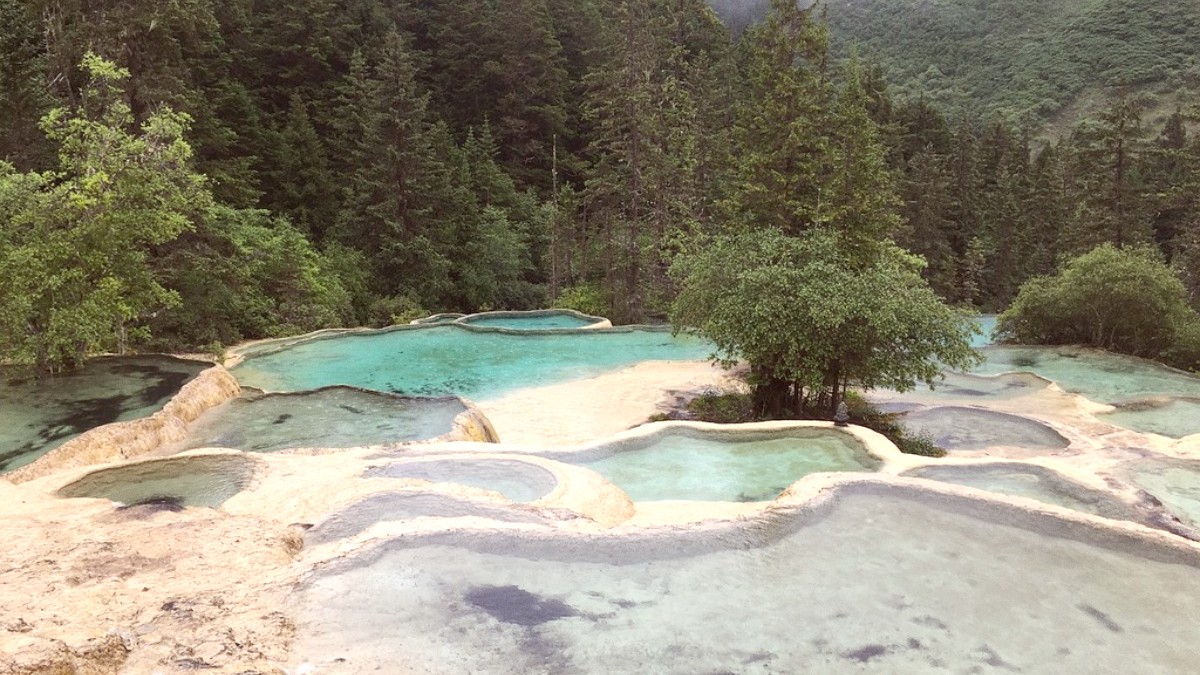
Sichuan, China
Rize Valley, the most scenic and popular branch, is often considered the heart of Jiuzhaigou's beauty, running southeast from the Nuorilang Waterfall junction. Shuzheng Valley is the first valley encountered from the park entrance, featuring numerous interconnected lakes and waterfalls.
Zechawa Valley, the longest and highest valley, stretches southeast from Nuorilang Waterfall and presents two main, impressive lakes.
The Rize Valley embodies the beauty of Jiuzhaigou, with each lake and waterfall offering an unique visual spectacle.
The largest and deepest lake in Jiuzhaigou, at the highest accessible elevation, surrounded by mountains.
One of the most stunning sights, known for its bright blues, greens, and yellows, a natural masterpiece of pigmentation.
Long Lake often freezes in winter, transforming the landscape.
The Five-Colored Pond's recovery from the 2017 earthquake made it a symbol of the park's renewal.
Despite its small size, the hues of Five-Colored Pond make it a must-see.
Jiuzhaigou's main focus lies in its natural scenery. Traditional museums dedicated to broad art or history are not present within the park or its immediate vicinity.
No major museums in Jiuzhaigou are dedicated to art or history in the traditional sense.
Some local venues in Zhangzha Town host Tibetan cultural shows, providing evening entertainment.
Art galleries or dedicated exhibition spaces are not a feature of Jiuzhaigou.
Any "exhibits" consist of environmental information displays within the park's visitor center.
These displays highlight the geology, flora, fauna, and conservation efforts of Jiuzhaigou.
Tibetan cultural shows offer a glimpse into local traditions as entertainment.
Within the park, traditional Tibetan villages like Shuzheng and Heye offer a glimpse into local culture and architecture.
Small Buddhist shrines or stupas can be found in or near Tibetan villages, reflecting local spiritual practices.
No significant archaeological sites or ruins exist within Jiuzhaigou National Park or its immediate surrounding areas.
Jiuzhaigou's historical significance lies more in its local cultural heritage than in ancient ruins or grand historical events. The region's past connects to the long-term habitation of Tibetan communities.
Jiuzhaigou itself is a collection of spectacular natural attractions. Its designated status as a nature reserve highlights its ecological importance.
The entire park provides a continuous series of interconnected natural wonders. Every turn on the boardwalks or bus routes reveals a new scenic viewpoint.
Jiuzhaigou is a nature reserve home to diverse wildlife, including endangered species, though sightings are opportunistic.
Understand park operating hours, fees, and guided options for a smooth visit.
Maximize your photography opportunities and avoid crowds with these insider tips.
Planning your visit carefully maximizes your time and experience in Jiuzhaigou's vast natural landscapes and cultural sites.
Allow at least two full days inside Jiuzhaigou National Park to explore its three valleys without rushing. This provides time for walking between bus stops, revealing many hidden perspectives. Consider purchasing tickets in advance, especially during peak seasons.
Buy park entrance tickets and bus tickets online or at the entrance. Booking ahead for peak times is advisable. Book your Jiuzhaigou tickets.
Utilize the park's internal bus system to navigate efficiently between major scenic spots. Buses stop at all main attractions.
Dining options within the park are limited, mainly found at Nuorilang Tourist Center. Pack snacks and water for convenience.
The boardwalks connecting many bus stops offer quieter experiences and different views of the landscapes.
Find guided toursThe quality of light changes throughout the day, offering diverse photographic opportunities.
Discover photo toursConsider visiting during shoulder season (April-May, September, November) for fewer crowds.
Plan your off-peak visitStay on designated paths and do not touch the water or formations to protect the delicate ecosystem.
Learn more about responsible travelThis valley, longest and highest, offers serene beauty. While shorter to explore, its two main lakes are truly impressive.
This valley forms the initial entry point to the park, showing numerous interconnected lakes and waterfalls as you ascend.
Avoid Chinese national holidays like Golden Week in May and October. The park becomes exceptionally crowded during these times, impacting the visitor experience.
While Jiuzhaigou is the main attraction, the surrounding region offers additional natural beauty and cultural insights.
A historic walled town, Songpan once served as an important military outpost and a bustling trading hub on the ancient Tea Horse Road. It stands approximately 90 kilometers (56 miles) from Jiuzhaigou.
A lesser-known scenic area, Munigou offers a less crowded experience with impressive natural features. It lies approximately 160 kilometers (100 miles) from Jiuzhaigou.
Another UNESCO World Heritage Site, Huanglong is famous for its unique calcified terraced ponds. It stands approximately 120 kilometers (75 miles) from Jiuzhaigou Valley.
Hiring a private car or taxi is highly recommended for flexibility.
The entire region surrounding Jiuzhaigou offers continuous views of forested peaks, rivers, and small Tibetan villages, providing stunning scenery.
Seasonal changes transform the landscape, from lush greenery to snow-covered peaks.
The region also offers opportunities to explore historical sites and experience authentic Tibetan village life outside the main park's immediate vicinity.
Some tour operators include brief stops in these villages, providing a glimpse into traditional life.
Arrive JZH, transfer to Jiuzhaigou (Day 1). Full day in Jiuzhaigou (Day 2). Another full day in Jiuzhaigou (Day 3). Day trip to Huanglong, then depart from JZH (Day 4).
Add a half-day or full-day visit to Songpan Ancient City. An overnight stay in Songpan offers a different ambiance.
Chengdu (capital of Sichuan) serves as the main gateway. Consider Leshan (Giant Buddha) or Mount Emei (Buddhist mountain) as extensions from Chengdu.